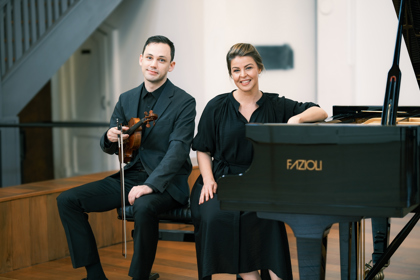'So the darkness shall be the light, and the stillness the dancing.’
This line of verse, from East Coker, one of T.S. Eliot’s Four Quartets (1943) is the inspiration for a recital of music which reveals composers at their most tragic and profound, juxtaposed with works of colourful vivacity in an affirmation of the dance of life.
Haydn’s F minor Variations (1793) is a heartfelt work written shortly after the death of Haydn’s close friend, Marianne von Genzinger. Unusually, it is a set of double variations, which also suggests the idea of two friends
The son of a Sierra-Leonean doctor and British mother, Coleridge-Taylor was one of the most eloquent composers to emerge from 19th-century Britain. His career was cut tragically short by an early death, but he achieved enduring international renown with his work Hiawatha’s Wedding Feast. The Three-Fours Suite (1909) reflects his gift for melodic invention and harmonic richness. The dances move from lively and capricious to a deeply-felt expressive lyricism and high drama. Each is marked by an irresistible charm and subtlety of rhythm evoking the elegance and joie-de-vivre of a bygone era.
Dulcie Holland studied with some of the leading composers of her generation, including Alfred Hill, John Ireland, Roy Agnew and the serial composer Matyas Seiber. Born in Sydney, she received an AO (Officer of the Order of Australia) amongst numerous other prestigious awards for her compositions. Her Nocturne, composed in 1947, combines aspects of Romantic Impressionism with an eloquent lyricism.
Described by Liszt historian Derek Watson as ‘a dark nocturnal confession of the soul’ Liszt’s La Vallee d’Obermann (1855) is a tour-de-force of Romantic pianism, which takes the listener on an unforgettable journey from the depths of despair to the heights of exultation.
Alberto Ginastera was one of the leading Latin-American composers of the 20th century, and a student of Aaron Copland. Danzas Argentinas (1937) are from his early nationalist phase, incorporating Argentinian folk idioms and culture and remains one of Ginastera’s most popular works.
Australian/Sierra-Leonean pianist Tonya Lemoh has made a career of championing forgotten composers. Labelled a ‘pianist archaeologist’ by a leading critic, her concert appearances and recordings have consistently garnered critical acclaim. Her breakthrough on the international stage came with the release of her solo recording of piano works by Austrian composer Joseph Marx for Chandos records. She was recently appointed Head of Keyboard at WAAPA.
Her current performance research is centred around composers of African descent Samuel Coleridge-Taylor and Florence Price, as well as original compositions based on Sierra-Leonean melodies, which will be featured in a solo recording for ABC Classics this year.
Partners






